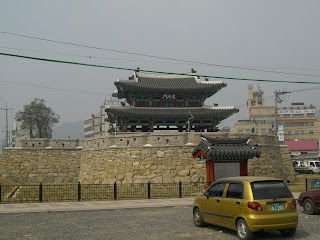Jason Lim
wrote a column in the
Korea Times and put together a survey to get to the bottom of this question. I didn't complete his survey---I doubt that something with "surveymonkey" in the title will influence policy---and it doesn't have any more significance than the scores of columns and letters on English education that have appeared in the
KT in recent weeks. And, it's a self-serving, deadline-meeting gesture on the part of a guy who
wrote a few months ago:
I still remember being chewed out by the president of the language institute I worked for 10 years ago because I hired a Korean American UCLA graduate who was far more qualified than one of those 'Let's travel through Asia while earning money as English teachers and score some women at the same time, dude!" types of instructors that were so prevalent in those days.
It doesn't really matter what native teachers think, and we are generally left out of the loop in school and in public policy. At my first private school Koreans designed the curriculum, chose the books, made the tests, appeared in the commercials, and got the performance bonuses. At my rural school district last year most of the English classes were taught by Korean teachers . . . entirely in Korean. The school was designated an "English research" school, though it didn't use a native speaker for classes, workshops, or editing. I wasn't even in the yearbook or mentioned on the school website. *frowny face* This year things go well enough, but I definitely don't have any role in the curriculum, the textbooks, or the test preparation, and as I see each class once every two or three weeks, I don't think I can really expect a larger role. I do wish I were on the school website, though. *frowny face* But in all seriousness, I think most 원어민 would agree that even in the best of situations and the most pleasant of schools they have a very reduced role and a limited influence on their classes. We're not considered real teachers, and even our titles are different: we're usually refered to as "native speaker" rather than English teacher.
When we talk about increased authority for native speakers in the world of English education here, we run up against a strong sense of pride among Korean teachers. I think that bars many of us from meaningful roles in the decision-making process. I guess in my more cynical moods I'd stick that under the umbrella of "Korea number 1" thinking. There's probably some truth to that, but it's probably better to say that the qualifications and credentials possessed by Korean teachers still trump our assets as native speakers. There have been many times when I've been asked for advice---when proofreading or editing or teaching---only to be disputed by Korean English teachers. A poster on
waygook.org talks about the vigilant defense of incorrect test questions, for example, and I've been through similar battles. I also remember last year when, after editing posters of song lyrics translated into English, and after correcting all the errors, the teacher in charge protested my changes (in Korean), and went ahead and posted the incorrect versions. And there's still the belief that, when we're not outright unqualified, we are not adequately trained to be effective teachers.
I do concede that a lot of us have never been trained as teachers. What skills does a 22-year-old biology major bring to Korea, other than his/her status as a native speaker? It must seem bat-shit crazy for some Koreans to even consider the advice of people like this. Though I did study Asian history and culture in college, and did learn some Korean along the way, me and my B.A. in English (just English) weren't much better. We can acquire skills along the way, though, but you know what, from an administrative perspective it doesn't matter. Public schools do, initially, pay a little more for advanced-degree holders and experienced teachers, but those folks are still singing songs and playing CD-ROMs like the rest of us. A certified teacher might cause a principal to momentarily swell with pride during one of the many degree checks, but you can bet that teacher doesn't have any more say in how English is taught in his school than you, I, or the 22-year-old biologist. And that's without even getting into the intertia of Korea's test-taking culture that dictates how English is taught in the first place.
There was a
letter to the editor in the
KT a week ago from a middle school teacher in Namwon, that gives some suggestions on improving "communication ability." One suggestion is:
Thirdly, we need to give teachers incentives, such as the chance to attend oversea language workshops for more than one year, or studying at universities TESOL programs for two years, in order for them to teach entire classes in English, If possible, the education ministry must sponsor teachers voluntarily attending workshops.
As I wrote
before, even without these hypotheticals, Korean English teachers have tons of opportunities for advanced study, from weekly workshops to intensive camps to overseas study. Why not make opportunities for professional advancement available to foreign teachers? It seems ridiculous, I'll grant, to ask the Korean government to sponser foreigners who may or may not have much personal investment in the country or in its schools. But, at least for me, I'd like to have something to show for my years in Korean public schools, something to make me valuable to my school and to future employers. I'd also like to see an organized evaluation system for foreign teachers here, one that takes into account not only years' experience but camps, contests, workshops, demonstration classes, extracurricular training, and language skills . . . all things for which Korean teachers are judged, organized, and rewarded. I'm not as concerned with money as some of my peers, and would be happy to stick around when the salaries flatline, but only if I had a stake in my school or my education board. And foreigners who have completed these programs might finally be seen as "qualified" in the eyes of the government and their colleagues.
Logic dictates that, if we're here on a visa, we're already qualified, since a visa presupposes a degree. (And so logic dictates that it's their own damn fault for hiring a 22-year-old biologist to teach TOEFL writing.) I've been through at least one major immigration crackdown, in December '05, that was supposed to tie up any loose ends and ensure that all loopholes had been closed. Evidentally I'm the only person who remembers that procedure, because we dealt with another moral panic this past fall.
 Picture I took at the crackdown in December, 2005. It's blurry, but I swear it happened.
Picture I took at the crackdown in December, 2005. It's blurry, but I swear it happened. The rub is "qualified" has a couple of meanings for Koreans. One is "possessing adequate credentials," and in that sense everybody with a degree, a passport from an English-speaking country, and a visa is qualified. A lot of times you'll see "unqualified teachers" refering to those teaching without the proper paperwork. But you'll also see "unqualified" refering to those who don't demonstrate proper, professional behavior (must resist the urge . . . ), a strong work ethic (
couldn't resist), or other intangibles (
sorry). Now, I'm going naively hope that this latest crackdown will be
another a "be all, end all" for teachers already in the country. But it seems like both sides are calling for a little more than that, and I'd like to see imported teachers given the same opportunity as their Korean colleagues and be allowed to beef up their qualifications. I don't see how that can be anything but a benefit to all involved.
That would also help create some semblance of organization among us, and establish some kind of leadership among our community and among, really, all English teachers. Contrary to Mr. Lim's article, there's no shortage of opinions from foreign English teachers. His paper's opinion page is full of about three new articles on it a day, and there are lots of messageboards filled with whines, complaints, questions, and opinions. Lim speaks of "high-ranking native English-speaking teachers," but there's no such thing. One would naturally want to put university professors at the top of the heap, but they're fraught with as much
discrimination and profesional dissatisfaction as any of us. As it stands now the only foreign teachers anyone hears from are the ones with the biggest blogs.
Oh well, it's just one column on policies that aren't even in place yet on a subject as . . . subject to change as any. I realize we're a transitory population and that there aren't many places in this world where foreigners' opinions are welcome. My point has always been that it's my native culture I'm teaching, my native culture my colleagues and students are butchering, and my native culture they're dictating in their policies, so I want my voice heard. Now, not even I want to hear the opinions of a lot of foreigners here, so how do we separate the serious from the riff-raff? Well, as I said up there, I'd like to see an internal system for qualifying foreign teachers, one consistent nationwide. Right now the organizing principle is experience and the reward is money.
That's assuming people are actually serious about hearing our opinions. They really need to cut the stereotyping shit out. Even an Ohmynews interview with the foreigner who exposed an
abusive daycare center in Itaewon couldn't go without
saying:
If you look at Dave’s ESL Cafe there are some foreigners involved in child sexual abuse and drug crimes and so on so the Korean media doesn’t like it, but you hope that this will cause the media to change for the better.
And it's worth remembering that Lee Myung-bak's ideas don't involve bringing in more foreigners, but rather training Koreans to do their jobs
in the first place better, so the influence of foreigners in the future oughtn't be overestimated. But, hey, with the throw
spaghetti against the wall money at the mess approach, it's about the only thing that hasn't been tried yet. Given the ridiculously
high ambitions and the shitty
domestic teachers, why not give it a go?







































